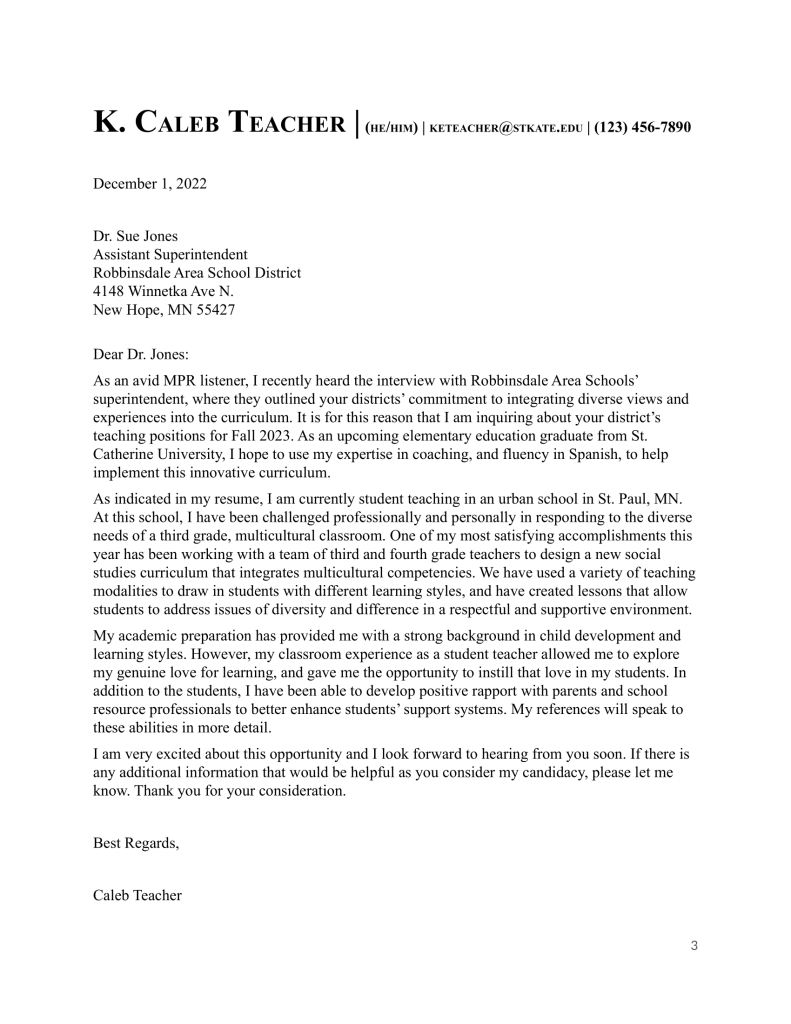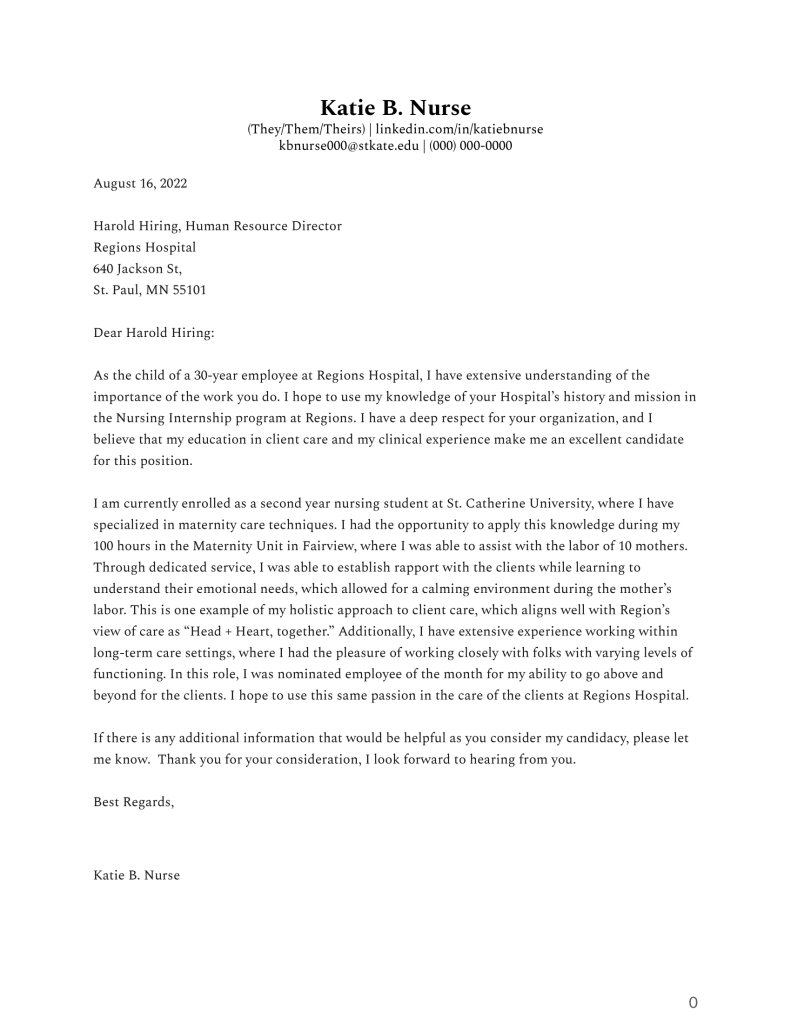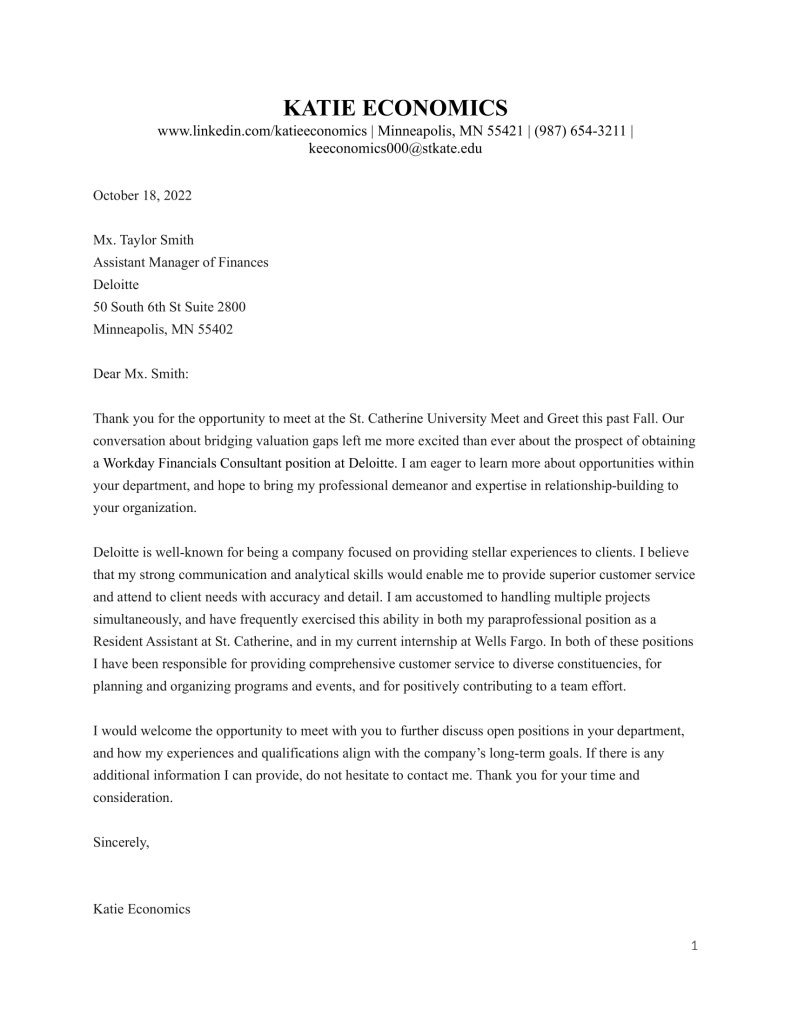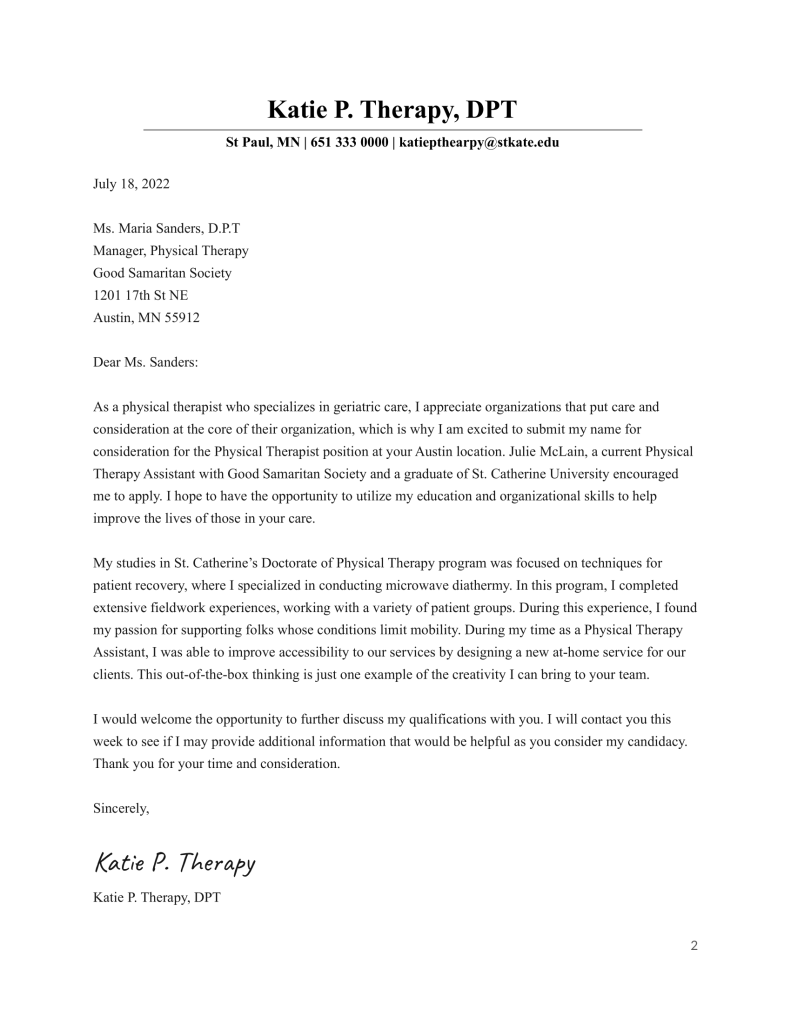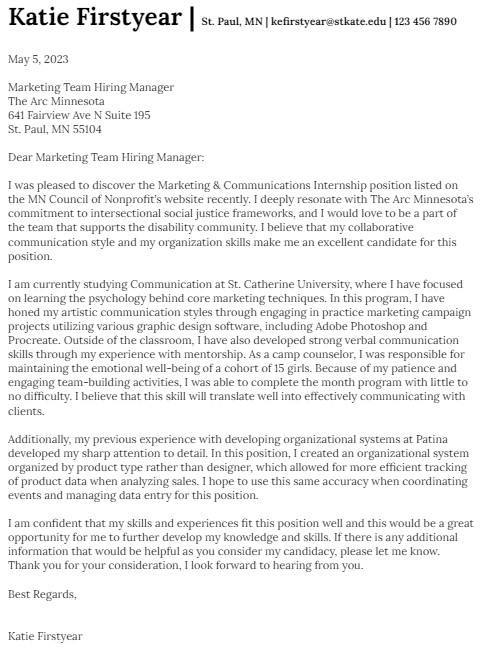What is a Cover Letter?
A cover letter is a letter written to a prospective employer, with the purpose of explaining who you are, and how your experiences make you a qualified candidate for a specific position. Think of it more like an argumentative essay, or a chance to show them who you are as a person.
The main purpose of a cover letter is to answer the question: Why are you the best candidate for the position?
Basic Tips
Cover letters should be tailored to each position you apply for. But, that doesn’t mean you have to start from scratch each time. Try to create a general guideline for yourself to follow when writing.
- Create a basic format. Using the templates on the “Templates” tab for examples.
- Brainstorm specific examples of how you fit the requirements for the position.
- Research the organization
Parts of a Cover Letter
- Formatting
- Heading
- Opening
- Body Paragraph(s)
- Closing
- Signature
-
FORMATTING
Use letter formatting. Include your contact information, the employer’s contact information, a salutation, body paragraphs, and a signature.
Try to address a specific person. Look for the hiring manager on the job posting, website, or on LinkedIn. If all else fails, try calling the employer and ask. Including titles (e.g. Mr., Dr., etc.) is traditional, but also assumes the recipient’s gender. Use your best judgment.
Keep your cover letter to one page.
Always proofread before submitting.
-
HEADING
The heading, at the top of your cover letter, should include the following:- Your Contact Information: Name, email address, and phone number. Optional: address or city/state of residence, pronouns, LinkedIn URL, eportfolio.
- Note: To create a cohesive brand for yourself, use the same heading as on your resume.
- Employer’s Contact Information: List the hiring manager’s name and title, organization name, and address information of the employer
- Salutation: Address your letter to a specific person (Use Mr./Ms./Mrs./Mx. if you know the person’s preferred pronouns/gender identity).
OPENING
This paragraph should answer the question: “Why are you interested in X specific job?” This is your chance to make a good first impression.
Sentence One: “Hook” the reader into the letter, without straying too far off topic. Think about a mutual connection, a belief statement, or express passion for what you do.
Example: “As a nurse practitioner who specializes in pediatric care, I see the importance of taking time to make connections with each client in my care.”
Sentence Two: Purpose of writing the cover letter (e.g. what job are you applying for? At what company? ). Integrate reasons why you’re interested in the organization or position.
Example: “I hope to be able to enhance your company’s innovative human resource services in the Employee Advocate position at Amazon.”
Sentence Three: Thesis statement/Main Points–What qualities/experiences do you uniquely bring to the position? Try to encapsulate 2-3 required or preferred qualifications for the position.
Example: “My work experience, coupled with my academic preparation, makes me an excellent candidate for a Brokerage Operations position.”
BODY PARAGRAPH(S)
This section should answer the question: “How are you qualified for this job?” With your body paragraphs, you want to list not only qualifications, but specific instances where you demonstrated those skills. And, you want to explain how that skill is relevant to the job you’re applying for.
Sentence One: State the main idea of your paragraph–what skill or quality are you focusing on? Ensure that this skill or quality aligns with the required or preferred qualifications in the job description.
Example: “I have spent the last year as the Graphic Design Intern at St. Catherine University, where I specialized in social media content creation.”
Middle Sentences: Provide evidence for your claim. How have you used that quality or experience previously?
Example: “In this role, I was able to harness my knowledge of organizational life cycle theory in a large corporate setting in order to maximize our team’s productivity. I personally designed and implemented a new system of interdepartmental communication. As a result of this work, our location reported the highest monthly sales numbers in the company for three months in a row.”
Final Sentence: Connect your examples to a specific requirement for the position you are applying for.
Example: “Working as a Fashion Merchandising Intern at Evine would allow me to continue to apply my knowledge of advanced construction methods and sustainable product development for a company that I value and respect.”
CLOSING
This paragraph should answer the question: “Why you (over another qualified applicant)?” The last paragraph is meant to summarize your main points, in a way that demonstrates that you are the best candidate for the position. How do you uniquely stand out from other applicants?
Sentence One: Reiterate your qualifications and interest in the company.
Example: “I am confident that my skills and drive fit this position well, and I would bring positive and professional energy to Greenspring Media.”
Sentence Two: State your interest in an interview, or in next steps of the job application process.
Example: “I look forward to meeting with you to discuss how my qualifications and experience would be an asset to your team.
Sentence Three: Thank them for their time and consideration.
Example: “Thank you for your time and consideration.”
SIGNATURE
The signature is at the bottom of the cover letter. It should include a sign off (e.g. “Sincerely,” “Best Regards,” etc.), and your name. You can include a handwritten signature, but that is optional.
Cover Letter Examples
All of the templates below are located in the KatieCareer Guide to Cover Letters. Select the button below to make a copy on Google Docs. Additionally, you can use the general outline linked here.
Click Below to Preview & Make a Copy
FAQ
While it may be listed as optional, cover letters can provide a lot of benefit to a job application. While it may be some work on the front end, having the opportunity to directly make the argument that you are the best candidate is beneficial. It’s an opportunity for an employer to hear your voice, understand your intentions, and learn about your personality, which are all often hard to convey in a resume format. Additionally, if it is listed as optional, that means it’s likely that a lot of people will not send a cover letter. So, submitting one with your application may help you stand out as a candidate.
The short answer is, yes. According to a 2020 study conducted by ResumeGo, 87% of respondents indicated that they do read cover letters. In addition, the study found that applicants who tailored their cover letters yielded about 50% more interviews when compared to those without.
It is more likely that your cover letter will be read if your application is being reviewed by a hiring committee or hiring manager, as opposed to a recruiter. This is because recruiters often have large amounts of applications to review for more open positions, compared to someone who is just looking to hire for one position.
In a short answer, no. A resume is meant to give an overview of your experiences and qualifications. Resumes answers the questions: who, what, where, when, and how. In contrast, a cover letter is an opportunity to add a crucial element: the why. Cover letters give an opportunity to explain exactly how you are qualified for the position you’re applying for.

